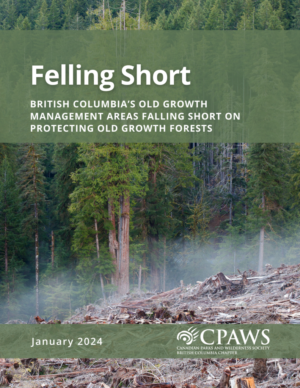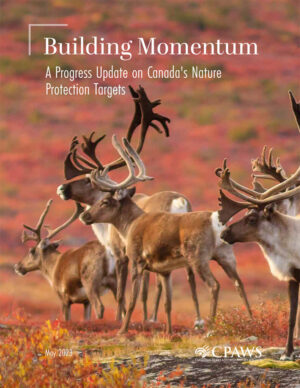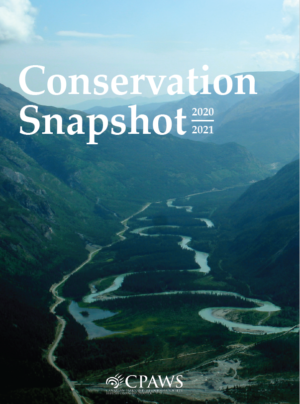All publications
MPA Monitor: Assessing Canada's Marine Protected Areas [October 2021]
CPAWS presents MPA Monitor: Assessing Canada’s Marine Protected Areas – a detailed report that investigates how well protected and well managed Canada’s Marine Protected Areas (MPAs) really are.
Presently, almost 14% of Canada’s ocean is protected and the country is committed to protecting 25% by 2025 and 30% by 2030. We analysed about half of the protected areas and found that the majority is weakly protected.
CPAWS is the first organization to use a ground-breaking new MPA evaluation tool, The MPA Guide, to examine 18 MPAs that make up 8.3% of Canada’s ocean. Learn More: cpaws.org/oceanreport
CPAWS-BC 2021 Annual Report
A look back at last year’s impact defending public lands and waters in BC. Thank you to our community of members, partners and staff, volunteers for your generous support. We couldn’t do this work without you.
The Grades Are In: A Report Card On Canada’s Progress in Protecting its Land and Ocean [June 2021]
The first of its kind, The Grades Are In: A Report Card On Canada’s Progress in Protecting its Land and Ocean is intended as a baseline against which to track Canada’s annual progress toward reaching its 30X30 protection goal. This assessment shows that a lack of commitment and ambition across much of the country stymied efforts to protect at least 17% of Canadian land and inland waters by last year’s 2020 deadline. Currently, only 13.1% of the country’s land is protected. Canada met its 10% ocean protection target by 2020 with 13.8% protected, albeit with concerns about the quality of conservation measures in some areas.
Healthy Nature, Healthy People: A call to put nature protection at the heart of Canada's COVID-19 recovery strategies [2020]
The Canadian Parks and Wilderness Society (CPAWS) highlights how the COVID-19 pandemic has revealed the critical role of Canada’s treasured parks and protected areas. They are not just important for protecting nature and tackling climate change, but also for maintaining Canadians’ health and well-being, and supporting a resilient, diversified economy. In the report, Healthy Nature Healthy People, CPAWS provides recommendations for how federal, provincial and territorial governments can provide health and economic benefits to Canadians by investing in protected areas.
Government investments bring Canada closer to conservation goals! [2020]
Getting to Canada’s new goals of 25% protection by 2025 and 30% by 2030 will take more leadership, including more investment by the federal government. The historic investment of 2018 is working. Let’s keep going!
Finding Common Ground: Six steps for tackling climate change and biodiversity loss in Canada [August 2019]
The Canadian Parks and Wilderness Society (CPAWS) unveiled its report, Finding Common Ground: Six steps for tackling climate change and biodiversity loss in Canada, providing a high-level roadmap for policy makers to harness ecosystem conservation and deliver win-win climate and biodiversity benefits by 2030.
Canada's Nature Emergency [July 2019]
CPAWS calls on Canada to champion a global goal of protecting and restoring half the earth, with a milestone target of protecting at least 30% of land and freshwater by 2030, and to commit to this at home.
Mind the Gap: Falling short on conserving biodiversity in BC. [2019]
As part of these goals, Canada has agreed to protect 17% of our lands
and inland waters by 2020 in a connected, representative, well-managed system of protected and conserved
areas. In the lead up to these meetings, the Canadian
Parks and Wilderness Society’s BC Chapter (CPAWSBC) has conducted a preliminary analysis of biodiversity conservation in BC and our progress towards these
targets.
Canadian Space for Nature Survey [June 2018]
The Canadian Space for Nature Survey found that across Canada there is overwhelming support for protected areas. 93% of Canadians believe that protected areas.
From Laggard to Leader: Canada's renewed focus on protecting nature could deliver results [2017]
CPAWS’ 2017 report “From Laggard to Leader? Canada’s renewed focus on protecting nature could deliver results,” encourages federal, provincial, and territorial governments to step up their protection efforts in order to conserve Canada’s natural heritage, and deliver on our international commitment.





![An Honest Accounting: Improving BC's Approach to Claiming Other Conserved Areas [February 2022] An Honest Accounting: Improving BC's Approach to Claiming Other Conserved Areas report finds select accounting of protected areas and other effective conservation measures (OECMs) designations do not meet international or Canadian standards, as set out in the Canadian Decision Support Tool.](https://cpawsbc.org/wp-content/uploads/2022/02/oecm-report-cover-300x373.jpg)
![MPA Monitor: Assessing Canada's Marine Protected Areas [October 2021] CPAWS presents MPA Monitor: Assessing Canada’s Marine Protected Areas – a detailed report that investigates how well protected and well managed Canada’s Marine Protected Areas (MPAs) really are. Presently, almost 14% of Canada’s ocean is protected and the country is committed to protecting 25% by 2025 and 30% by 2030. We analysed about half of the protected areas and found that the majority is weakly protected. CPAWS is the first organization to use a ground-breaking new MPA evaluation tool, The MPA Guide, to examine 18 MPAs that make up 8.3% of Canada’s ocean. Learn More: cpaws.org/oceanreport](https://cpawsbc.org/wp-content/uploads/2021/10/mpa-monitor-cover-300x366.jpg)

![The Grades Are In: A Report Card On Canada’s Progress in Protecting its Land and Ocean [June 2021] The first of its kind, The Grades Are In: A Report Card On Canada’s Progress in Protecting its Land and Ocean is intended as a baseline against which to track Canada’s annual progress toward reaching its 30X30 protection goal. This assessment shows that a lack of commitment and ambition across much of the country stymied efforts to protect at least 17% of Canadian land and inland waters by last year’s 2020 deadline. Currently, only 13.1% of the country’s land is protected. Canada met its 10% ocean protection target by 2020 with 13.8% protected, albeit with concerns about the quality of conservation measures in some areas.](https://cpawsbc.org/wp-content/uploads/2021/06/parks-report-2021-300x340.jpg)
![Healthy Nature, Healthy People: A call to put nature protection at the heart of Canada's COVID-19 recovery strategies [2020] The Canadian Parks and Wilderness Society (CPAWS) highlights how the COVID-19 pandemic has revealed the critical role of Canada’s treasured parks and protected areas. They are not just important for protecting nature and tackling climate change, but also for maintaining Canadians’ health and well-being, and supporting a resilient, diversified economy. In the report, Healthy Nature Healthy People, CPAWS provides recommendations for how federal, provincial and territorial governments can provide health and economic benefits to Canadians by investing in protected areas.](https://cpawsbc.org/wp-content/uploads/2021/01/Screen-Shot-2020-07-15-at-2.45.21-AM-232x300-1-300x387.png)
![Government investments bring Canada closer to conservation goals! [2020] Getting to Canada’s new goals of 25% protection by 2025 and 30% by 2030 will take more leadership, including more investment by the federal government. The historic investment of 2018 is working. Let’s keep going!](https://cpaws.org/wp-content/uploads/2020/02/CPAWS-Protection-in-Progress-report-e1582126534770.png)
![Finding Common Ground: Six steps for tackling climate change and biodiversity loss in Canada [August 2019] The Canadian Parks and Wilderness Society (CPAWS) unveiled its report, Finding Common Ground: Six steps for tackling climate change and biodiversity loss in Canada, providing a high-level roadmap for policy makers to harness ecosystem conservation and deliver win-win climate and biodiversity benefits by 2030.](https://cpawsbc.org/wp-content/uploads/2019/10/2019ClimateReportCover-1-300x388.jpg)
![Canada's Nature Emergency [July 2019] CPAWS calls on Canada to champion a global goal of protecting and restoring half the earth, with a milestone target of protecting at least 30% of land and freshwater by 2030, and to commit to this at home.](https://cpawsbc.org/wp-content/uploads/2020/02/Parks-report_2019-300x389.jpeg)
![Mind the Gap: Falling short on conserving biodiversity in BC. [2019] As part of these goals, Canada has agreed to protect 17% of our lands and inland waters by 2020 in a connected, representative, well-managed system of protected and conserved areas. In the lead up to these meetings, the Canadian Parks and Wilderness Society’s BC Chapter (CPAWSBC) has conducted a preliminary analysis of biodiversity conservation in BC and our progress towards these targets.](https://cpawsbc.org/wp-content/uploads/2020/02/mitigate-_-adapt-3-300x300.png)
![Canadian Space for Nature Survey [June 2018] The Canadian Space for Nature Survey found that across Canada there is overwhelming support for protected areas. 93% of Canadians believe that protected areas.](https://cpawsbc.org/wp-content/uploads/2020/02/nature_survey-report-2018-300x329.jpg)
![From Laggard to Leader: Canada's renewed focus on protecting nature could deliver results [2017] CPAWS’ 2017 report “From Laggard to Leader? Canada's renewed focus on protecting nature could deliver results,” encourages federal, provincial, and territorial governments to step up their protection efforts in order to conserve Canada’s natural heritage, and deliver on our international commitment.](https://cpawsbc.org/wp-content/uploads/2020/02/mitigate-_-adapt-5-300x300.png)